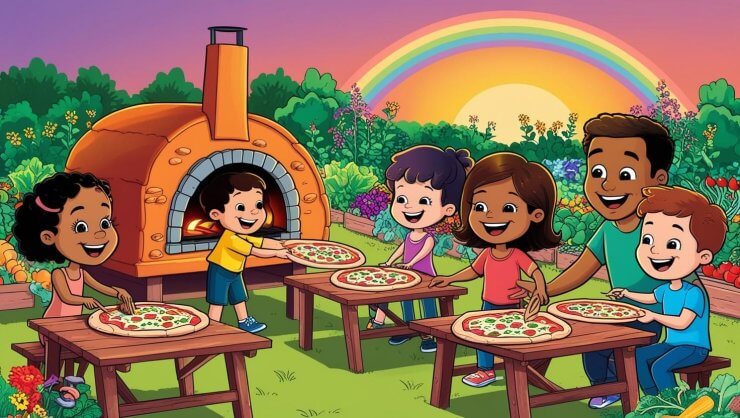Read by Matilda Longbottom

Imagine a dining experience straight out of a dream: tables laden with artisan foods, cheeses, and garden-fresh vegetables. The setting sun casts a golden glow, and a rainbow arches over the lush plots of a community garden. Laughter and conversation fill the air as someone reaches over to clip a handful of rosemary from a nearby garden plot, adding a fresh-picked herb to the meal. Sharing is natural here. This is the magic of the Community Oven.
At another table, folks arrive with picnic baskets, plastic chairs, and even pop-up tents. Birthday cakes and checkered tablecloths make appearances. Those without toppings like basil, pepperoni, or mushrooms contribute side dishes to share.
You might mistake this for a pricey farm-to-table dinner, the kind requiring reservations and a hefty fee. But here, no one pays, and no one is turned away.
Newcomers mingle with families who have been coming for years. Kids, parents, and grandparents roll out dough, top it with cheese, sauce, and whatever else is on the table. The fire master loads their creations into the wood-fired oven on a long paddle, keeping a watchful eye until the pizzas emerge bubbly and hot. Sometimes, he even lets an eager diner help. All around, people proudly show off their pizzas adorned with mozzarella, prosciutto, or just-picked oregano.
First-timers often ask, “How did this all start?” They gesture at the impressive domed masonry oven, the stack of firewood, and the glowing coals.
“The town made it possible,” is the answer. In this small community, “town” means both the local residents and the town government that supported the project.
“Did the town hire a crew to build it?” someone asks.
“No, it was built by volunteers.”
“Did the town government pay for it then?”
No, the community came together, pooling resources. Small businesses provided supplies at cost—cement, cinder blocks, bricks, metal. People wrote checks, not large ones, but enough. The oven itself stands tall, with its fire chamber at heart level.
“And, how did you know how to build it?”
“We didn’t. We had no idea what we were doing,” comes the reply, a shared belief after 13 years of community baking. “You do it, and then you know how to do it.” Someone nods, recalling a time they learned by doing.
The Community Oven project began with a set of instructions. A local craftsman, who had once helped build a pizza oven, volunteered to lead the work. Though he was a blacksmith, not a stonemason, he dedicated a Summer’s worth of Saturdays to oversee construction. He even donated stunning copper oven doors, etched with the words, “The flavor of bread shared has no equal.” Another local secured donations, believing that baking bread together was an idea too good to fail. The project attracted foodies, an excavator and his son who did the foundation work for free, and artisans from a decorative stone company who finished the oven with red stone matching the surrounding hills. Volunteers provided lunches and shade for the laborers.
Some have been coming to the Community Oven since its inception. First-timers are often moved, realizing, “This is what community is all about.” Someone passes them fresh-chopped tomatoes and says, “Sure is.” Old-timers share stories of baking in snowstorms before the shelter was built, the “Midnight Stoker” who tended the fire at night, and the pastry chef from Aspen who baked Pan de Muertos for the Day of the Dead, honoring ancestors with a blend of Spanish and English conversations.
Would a community oven benefit your community? Without a doubt, it will bring people together. Imagine the aroma of hot, steamy loaves and fragrant pizzas. Look around and see family, strangers, and neighbors. Pass a fresh-baked baguette and watch the magic happen. ❖
About the Author: Linda Romero Criswell is the author of the novel “Watermelon Snow” and one of the founders of the Carbondale Community Oven. She bakes all her own bread and has taught bread baking. Sometimes she gathers wild yeast in her garden, but that’s another story. Her work has appeared in numerous small literary publications. This is her third story for GreenPrints.


 Previous
Previous

